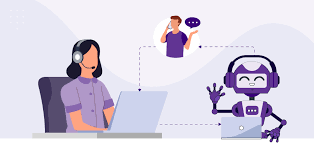In the dynamic landscape of customer service, call deflection emerges as a strategic approach to enhance efficiency and customer satisfaction. This innovative technique aims to divert incoming calls away from traditional support channels, such as call centers, toward alternative and often more efficient resolution pathways. In this article, we will delve into the realm of call deflection, exploring its significance, various strategies, and the impact it has on streamlining customer support processes.
Unpacking the Concept of Call Deflection
Understanding Call Deflection
Call deflection is a customer service strategy designed to minimize the volume of incoming calls to traditional support channels. Rather than relying solely on phone-based assistance, businesses implement various techniques to guide customers toward alternative means of issue resolution. These alternatives may include self-service options, online resources, or automated systems that can address common queries without the need for direct human intervention.
The Evolution of Customer Support
Traditionally, customer support heavily relied on call centers, where customers dialed in with their queries or concerns. However, as technology advanced and customer expectations shifted, businesses recognized the need for more diverse and efficient support mechanisms. Call deflection emerged as a proactive response to this evolution, aiming to optimize the customer experience by providing quicker and more convenient solutions.
Strategies for Successful Call Deflection
Self-Service Portals
One of the primary strategies in call deflection involves the implementation of self-service portals. These online platforms empower customers to find answers to common questions, troubleshoot issues, or access relevant information without the need to initiate a phone call. Well-designed knowledge bases, FAQs, and tutorial resources contribute to successful self-service call deflection.
Interactive Voice Response (IVR) Systems
Interactive Voice Response (IVR) systems play a pivotal role in call deflection by automating certain aspects of customer interactions. Through pre-recorded voice prompts and keypad inputs, customers can navigate through a series of options to find the information they need or resolve basic queries without speaking to a live agent. IVR systems efficiently handle routine tasks, freeing up human agents for more complex issues.
Chatbots and Virtual Assistants
The integration of chatbots and virtual assistants represents a cutting-edge approach to call deflection. These AI-driven entities can engage with customers in real-time, providing instant responses to queries and guiding users through issue resolution steps. Chatbots excel in handling repetitive tasks and can seamlessly transition customers to human agents if needed.
Advantages of Implementing Call Deflection Strategies
Enhanced Efficiency and Cost Savings
One of the most significant advantages of call deflection strategies is the enhanced efficiency they bring to customer support processes. By automating routine tasks and directing customers to self-service options, businesses can reduce the workload on human agents, leading to faster response times and cost savings.
Improved Customer Satisfaction
Efficient call deflection contributes to improved customer satisfaction. Customers appreciate quick and accessible solutions to their queries. By providing self-service options and streamlined resolution pathways, businesses can meet customer expectations and foster positive experiences, ultimately enhancing brand loyalty.
Optimized Resource Allocation
Call deflection allows businesses to optimize the allocation of resources within their customer support infrastructure. Human agents can focus on addressing complex issues that require personalized attention, while routine tasks and common queries are efficiently handled through automated systems and self-service options.
Overcoming Challenges in Call Deflection Implementation
Balancing Automation with Human Touch
While automation is a key component of call deflection, finding the right balance between automated systems and human interaction is crucial. Striking this balance ensures that customers receive personalized attention when needed, preventing a potential drawback of call deflection—customer frustration due to a lack of human engagement.
Ensuring Accuracy and Relevance of Self-Service Resources
The success of call deflection hinges on the accuracy and relevance of self-service resources. If knowledge bases, FAQs, or automated systems provide outdated or incorrect information, it can lead to customer dissatisfaction. Regular updates, quality control measures, and monitoring customer feedback are essential to maintaining the effectiveness of call deflection strategies.
Addressing Customer Resistance to Automation
Some customers may prefer human interaction over automated systems, leading to potential resistance to call deflection strategies. Addressing this resistance requires clear communication about the benefits of automation, ensuring that customers understand how automated processes contribute to quicker issue resolution and improved overall service.
Future Trends in Call Deflection Technology
Integration of Artificial Intelligence and Machine Learning
The future of call deflection technology lies in the integration of advanced artificial intelligence (AI) and machine learning (ML) capabilities. These technologies can enhance the accuracy and responsiveness of automated systems, allowing for more sophisticated interactions with customers. Predictive analytics powered by AI and ML can anticipate customer needs, further optimizing call deflection strategies.
Expansion of Omnichannel Support
The evolution of call deflection extends beyond traditional channels. Future trends indicate a broader implementation of omnichannel support, where customers can seamlessly transition between various communication channels, such as phone calls, chat, email, and social media. This holistic approach ensures a consistent and integrated customer experience.
Personalization Through Customer Data Utilization
As businesses accumulate vast amounts of customer data, personalized call deflection strategies are likely to become more prevalent. Leveraging customer data allows businesses to tailor automated responses and self-service options based on individual preferences and past interactions, creating a more personalized and customer-centric experience.
Conclusion
In conclusion, call deflection represents a pivotal shift in the landscape of customer support, driven by the need for efficiency, cost-effectiveness, and enhanced customer satisfaction. By strategically implementing self-service options, automated systems, and emerging technologies, businesses can not only streamline their support processes but also build stronger connections with their customer base. As we look to the future, the continued evolution of call deflection technology holds the promise of more sophisticated and personalized customer experiences, ultimately redefining the way businesses engage and assist their clientele.
